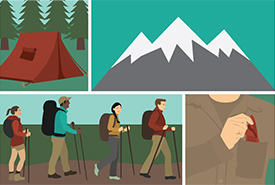Leaving no trace during outdoor adventures

Leaving no trace during outdoor adventures (Graphic by Fix.com)
Anyone lucky enough to spend a significant amount of time in the wilderness can appreciate pristine nature… and they have likely seen people’s negative impacts on the outdoors. No one heads down a trail or to a campsite planning to mar it, but leaving it the way one found it is harder than it might seem. Fortunately, the Leave No Trace organization has provided absolute guidelines to help anyone tread lightly on precious wilderness areas.
On the trail
Hikers begin affecting the environment while they are on the trail. It’s crucial for families and individuals to leave each trail with minimum impact. Here’s how:
Never drop trash: A no-brainer, right? But as many of us know, it is so often ignored. Remember, cigarette butts and chewed gum count as trash, too. Tip: Take snack foods out of pre-packaged wrappers before heading out. This way, you’ll have less trash to take back home with you.
Never take shortcuts: Why? Taking shortcuts, which is especially tempting when switchbacks zigzag up a mountain, causes erosion over time. When enough hikers take a given shortcut up a hillside, this new “trail” ruins vegetation and causes runoff during rain storms.
Respect the trail: It’s fun to talk with your trail mates while hiking, but walking single file where the trail is narrow is important. As with trail cutting, widening trails by walking double or triple across ruins trailside vegetation, not to mention the aesthetics of the trail.
Adhere to trail limitations: At the start of any trail, a sign will indicate what methods of transportation are allowed. Adhere to this, and don’t bring motorized vehicles on hike-only or bike-only trails.

Trails dos and don'ts. (Graphic by Fix.com)
While camping
Campsites create the most wear and tear on the environment. But you can reduce your impact in a few easy ways:
Camp in designated spots: Even in wilderness areas, it’s usually possible to spot a designated campsite by the presence of a fire ring (which is man-made by park service personnel). It’s also usually obvious where previous campers placed their tents. Use the same areas, which are already flattened or somewhat trampled, to pitch your tent rather than breaking new ground.
Put out campfires properly: Whether in campgrounds or in wilderness areas, campfires, when permitted, are a fun part of camping. Always make campfires in designated rings, and put them thoroughly before departing. Typically, it will take four or five buckets of water to completely put out a campfire (you’ll know that it’s properly out when the ring stops smoking, but stir the ashes with a stick to make sure it’s not still smoldering lower down). When building your fire, use wood pieces no thicker than your wrist to ensure that the wood burns out completely before bedtime.

How to put out a campfire. (Graphic by Fix.com)
Place your "kitchen sink" and "bathroom" away from water sources: Human waste does not belong near bodies of water. Designate a bathroom area at least 300 feet from any lake, river, or stream and do the same for kitchen tasks such as washing dishes (or yourself).
Use biodegradable soap: Found at any outdoor store, biodegradable soap can be used on kitchen utensils, pots and pans as well as on yourself. Use only this soap, which breaks down quickly and easily, as shampoo and even laundry detergent. To wash yourself using Leave No Trace practices, give yourself a sponge bath away from water sources and dispose of bath or dishwater a distance away from lake or river beds, in ferns or other foliage. Some campers like to use a solar shower, with water warmed by the sun. To stay clean between baths, enjoy lake or river swims!

How to store food at night. (Graphic by Fix.com)
Whenever you're in the wilderness
Even when you don’t plan to spend the night in the outdoors, we encourage all hikers and nature lovers to follow Leave No Trace’s seven principles. Remembering the following core guidelines will ensure that you leave the wilderness as you found it, every time:
Know your route: This includes carrying maps and compasses or GPS devices to eliminate the need to mark trails with rocks or flagging.
Camp on durable surfaces: Remember our campsite rules? Pitch tents where others have before you, and avoid marshy or wetland areas.
Pack out waste: Bring trash bags to store garbage, including toilet paper.

How to pack out trash. (Graphic by Fix.com)
Respect wildlife: Most outdoor enthusiasts know not to feed wildlife, but it can happen accidentally (leaving you hungry yourself!) if you don’t store food properly. Store food in a bag suspended at least 13 feet in the air and 7 feet away from the tree trunk at night and well away from tents, or use odor-proof bear canisters. Some campsites offer bear lockers on-site. Remember, some animals can and will get into locked cars!
Leave what you find: This rule is a tough one for kids. It means leaving that pretty rock or special feather where you found it. This doesn’t mean you can’t admire it — take a photo and place the image in a trail journal, or sketch special finds.
Minimize campfire impact: Resist making a huge fire. Only use dead or broken branches found on the forest floor to make your fire, checking for critters underneath before taking for fire. Better yet, use a backpacking stove instead.
Be considerate of others: Give uphill hikers the right of way, and keep noise to a minimum. No need to bring music players or loud voices to the outdoors. Most people appreciate a guitar, however!
Follows these tips to leave no trace, ensuring that the wilderness will be pristine the next time you stop by for a visit!
This post was originally featured on Fix.com and is reposted with permission on Land Lines.


